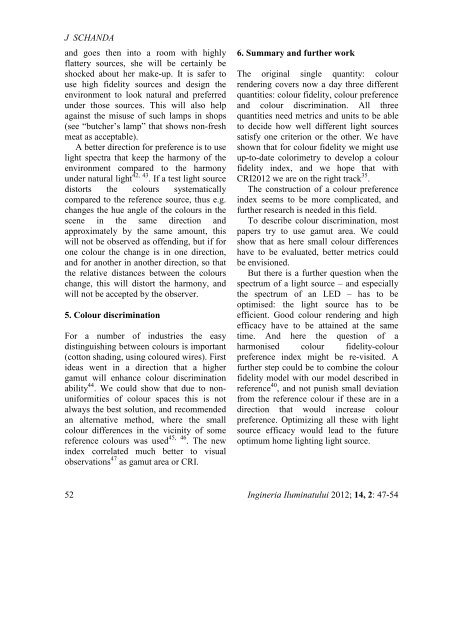Untitled - Journal of Lighting Engineering
Untitled - Journal of Lighting Engineering
Untitled - Journal of Lighting Engineering
Create successful ePaper yourself
Turn your PDF publications into a flip-book with our unique Google optimized e-Paper software.
J SCHANDA<br />
and goes then into a room with highly<br />
flattery sources, she will be certainly be<br />
shocked about her make-up. It is safer to<br />
use high fidelity sources and design the<br />
environment to look natural and preferred<br />
under those sources. This will also help<br />
against the misuse <strong>of</strong> such lamps in shops<br />
(see “butcher’s lamp” that shows non-fresh<br />
meat as acceptable).<br />
A better direction for preference is to use<br />
light spectra that keep the harmony <strong>of</strong> the<br />
environment compared to the harmony<br />
under natural light 42, 43 . If a test light source<br />
distorts the colours systematically<br />
compared to the reference source, thus e.g.<br />
changes the hue angle <strong>of</strong> the colours in the<br />
scene in the same direction and<br />
approximately by the same amount, this<br />
will not be observed as <strong>of</strong>fending, but if for<br />
one colour the change is in one direction,<br />
and for another in another direction, so that<br />
the relative distances between the colours<br />
change, this will distort the harmony, and<br />
will not be accepted by the observer.<br />
5. Colour discrimination<br />
For a number <strong>of</strong> industries the easy<br />
distinguishing between colours is important<br />
(cotton shading, using coloured wires). First<br />
ideas went in a direction that a higher<br />
gamut will enhance colour discrimination<br />
ability 44 . We could show that due to nonuniformities<br />
<strong>of</strong> colour spaces this is not<br />
always the best solution, and recommended<br />
an alternative method, where the small<br />
colour differences in the vicinity <strong>of</strong> some<br />
reference colours was used 45, 46 . The new<br />
index correlated much better to visual<br />
observations 47 as gamut area or CRI.<br />
6. Summary and further work<br />
The original single quantity: colour<br />
rendering covers now a day three different<br />
quantities: colour fidelity, colour preference<br />
and colour discrimination. All three<br />
quantities need metrics and units to be able<br />
to decide how well different light sources<br />
satisfy one criterion or the other. We have<br />
shown that for colour fidelity we might use<br />
up-to-date colorimetry to develop a colour<br />
fidelity index, and we hope that with<br />
CRI2012 we are on the right track 35 .<br />
The construction <strong>of</strong> a colour preference<br />
index seems to be more complicated, and<br />
further research is needed in this field.<br />
To describe colour discrimination, most<br />
papers try to use gamut area. We could<br />
show that as here small colour differences<br />
have to be evaluated, better metrics could<br />
be envisioned.<br />
But there is a further question when the<br />
spectrum <strong>of</strong> a light source – and especially<br />
the spectrum <strong>of</strong> an LED – has to be<br />
optimised: the light source has to be<br />
efficient. Good colour rendering and high<br />
efficacy have to be attained at the same<br />
time. And here the question <strong>of</strong> a<br />
harmonised colour fidelity-colour<br />
preference index might be re-visited. A<br />
further step could be to combine the colour<br />
fidelity model with our model described in<br />
reference 40 , and not punish small deviation<br />
from the reference colour if these are in a<br />
direction that would increase colour<br />
preference. Optimizing all these with light<br />
source efficacy would lead to the future<br />
optimum home lighting light source.<br />
52 Ingineria Iluminatului 2012; 14, 2: 47-54
















